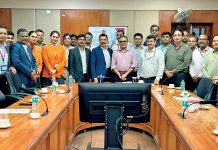There is need to set up statutory bodies, standardise policies, enhance upskilling, incentivise automation among others, says Niti Doshi, Director & Head, Branding & Marketing, NIDO Group. The govt must frame policies, outline norms for automation deployment, ensure compliance and the like, she adds.
CT Bureau
Do investments made in warehouse automation in 2023 impact operations?
In the past year, NIDO has invested across three key major areas: manpower, infrastructure, and R&D. These investments are instrumental in enhancing operational efficiency and driving innovation within our warehouse automation initiatives. Firstly, resources have been dedicated to bolstering our manpower capabilities. Secondly, substantial investments have been directed towards enhancing our infra. We have acquired cutting-edge equipment such as CNC machines, laser cutting machines, bending machines, and quality inspection machines.
These investments have optimized our processes and enabled us to deliver quality products in an efficient manner thereby enhancing our operational agility. NIDO has invested in R&D aimed at fostering innovation and product development. These investments have facilitated the conceptualization, testing, and refinement of new products.
Can you cite any instances of how automation solutions handle cargo efficiently?
NIDO’s automation solutions are designed to handle a range of cargo types efficiently and securely, catering to needs of each cargo category. Here are some examples: for palletised goods, we have the IZAR and SIRIUS range of AMRs and AGVs equipped with pallet handling attachments. These AGVs are programmed to navigate through the warehouse autonomously, picking up and transporting pallets to designated loading docks.
Robotic palletizers have been employed to stack and organise palletised goods within the warehouse, optimising storage space and minimise manual handling. Automated conveyor systems are used for transport of cartons and boxes within the warehouse. These conveyors are equipped with sensors and sortation technologies to route each carton to its designated destination.
Robotic pick-and-place systems enhance efficiency by automating the process of picking individual cartons from storage locations and place them onto conveyors for outbound shipping. ASTRO, our latest innovation, offering cost-effective solutions to handle a range of product profiles and ensure accurate and high-speed sorting.
With a compact footprint and easy deployment, ASTRO’s design guarantees seamless growth, while minimizing operational costs. For irregularly shaped items or non-standard cargo, robotic arms equipped with advanced vision systems are deployed for flexible and precise handling. These robotic arms can grasp and manipulate products of different shapes, sizes, and weights with accuracy, ensure secure handling and minimize risk of damage during transportation and storage.
In facilities, automated storage, and retrieval systems with climate-controlled environments are employed for handling temperature-sensitive goods such as perishables and pharmaceuticals, and preserving the integrity of the cargo throughout the storage and retrieval process thereby ensuring compliance with regulatory requirements and preserving product quality. For high-value or secure items, automated inventory management systems with integrated security features such as RFID tagging, biometric access control, and video surveillance are implemented. These systems provide real-time visibility into inventory movements, track chain of custody, and ensure compliance with security protocols to prevent theft or unauthorised access to sensitive cargo.
What benefits do you see from initiatives such as PMGS and NLP?
Their overarching goals include reducing logistics costs, improving LPI ranking, and fostering data-driven decision support mechanisms, all of which contribute to an efficient and competitive logistics ecosystem in the country. By placing logistics in the spotlight, these initiatives increase awareness of the industry’s importance in driving economic growth. Industry stakeholders become aware of industry developments, leading to a shared understanding of challenges and opportunities. The government’s push translates into investments in infrastructure, technology, and policy reforms, laying the groundwork for a robust logistics ecosystem.
Should govt create a tech ecosystem and implement talent growth in logistics?
The government can undertake initiatives such as establishing relevant statutory bodies, standardising policies, rules, enhancing curricula, upskilling programmes in educational institutions, promote startups, incubation services, incentivise adoption of automation technologies and foster innovation and experimentation. The government can create specialised bodies tasked with promoting and facilitating automation technology adoption in logistics. Rather than acting as enforcers, these bodies must offer guidance, resources, and best practices to the industry stakeholders.
The government should work towards framing clear and comprehensive policies that outline norms for automation deployment, while ensuring compliance with safety, security, and ethical standards. Educational initiatives must lay stress on practical skills and application of automation in logistics. Programmes providing budding entrepreneurs with access to mentorship, funding, and infrastructure support in order to develop innovative automation solutions for the logistics industry must be encouraged.
To encourage businesses to invest in automation technologies, the government must introduce tax breaks, subsidies, or grants for the automation equipment purchases and implementation. To foster an environment conducive to innovation within the logistics industry, initiatives such as innovation challenges and technology would encourage industry stakeholders to explore and adopt emerging automation solutions. By implementing them, the government can create an enabling ecosystem that supports the widespread adoption of automation technologies and foster development of a skilled workforce capable of driving innovation and growth in the sector.














